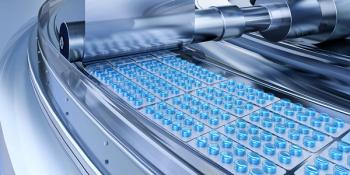
Equipment and Processing Report
- Equipment and Processing Report-01-16-2013
- Volume 0
- Issue 0
Using Micronization to Reduce API Particle Size
Micronization can be performed with a jet mill or bead mill.
Micronization, which reduces particles down to the micrometer or, in some cases, nanometer (1/1000 of a micrometer) size, can be used to improve the bioavailability of poorly soluble APIs by increasing particle surface area and accelerating dissolution rates. Micronization can also be used to improve formulation homogeneity and control particle size. A wide range of drug types, including solid dosage, injectable, ocular, and inhaled products, can benefit from micronization. Micronization is most often used to describe processes that reduce particle size by using fluid energy, such as a jet mill, rather than by mechanical means. Mechanical particle-size reduction using a bead mill, however, can also be used to obtain micrometer- and nanometer-sized particles.
Jet milling
Jet milling does not use mechanical components, but instead uses pressurized gas to create high particle velocity and high-energy impact between particles. After exiting the jet-mill chamber, the process gas is separated from the solid particles with a cyclone filter. Compared with mechanical milling, jet milling reduces metal contamination and, because process temperature is relatively constant, can be used for heat-sensitive products, explained Giovanni Gianola, managing director of FPS Food and Pharma Systems (FPS) at a recent industry seminar (1). Jet milling, however, has relatively low productivity, large equipment size, and high process-gas flow requirements, therefore requiring high process knowledge to optimize its use. Micronization using spiral jet milling has been a poorly understood “black box” process, but process understanding is growing as pharmaceutical companies work together with equipment manufacturers, said Gianola. Parameters include equipment geometry, temperature, and powder characteristics (e.g., humidity, density, impurities, and incoming particle size distribution) as well as the variables of pressure and solid-feed rate (i.e., specific energy). Improved understanding can lead to improvements in productivity, particle size distribution, and gas consumption, for example. Temperature control for cryogenic applications is also being investigated and adopted, says Gianola.
The desired particle size depends on the solid-dosage requirements, notes Brian List, sales and marketing manager at the Jet Pulverizer Company, with typical API particle sizes in the 2–5 micrometer range. The minimum particle size that can be obtained using a jet mill depends on the inner friability of the material, explains List. Many APIs are synthesized or precipitated at the nanometer-scale but are agglomerated, and a jet mill can also be used to deagglomerate these APIs down to their original nanometer base-particle size.
Jet milling under containment
Because of the prevalence of potent compounds, micronization is increasingly being performed under isolation. A mill can be enclosed inside a barrier isolator for processing highly potent drugs. In addition, jet mills can be operated in sterile conditions by integrating the mill in an isolator or a restricted access barrier system (RABS) as needed, notes Gianola.
Some products are not considered potent, yet still require containment because of environmental, health, and safety (EHS) concerns as a result of the small particles created after the micronization process, notes Mike McDougal, director of sales and marketing at Micron Technologies, which provides micronization and analytical services to the pharmaceutical industry. The company has custom-designed containment systems that provide the ability to jet mill high volumes of product under containment.
Jet mills can be designed with tool-less, sanitary-clamp connections to allow easy assembly and disassembly inside a glovebox. A recently introduced spiral jet mill was simplified with fewer parts for even easier assembly, says List (Pharma-Master, The Jet Pulverizer Company). This mill, which has been awarded USDA acceptance, also minimizes hang-up points to improve cleanability and includes a one-piece, weldless feed funnel injector.
Bead milling
There is increasing interest in bead milling as a micronization method for pharmaceuticals, says Randy Smith, president of Netzsch Premier Technologies, a US-based company in the Netzsch Group’s Grinding and Dispersing business unit. A bead mill uses wet mechanical milling to obtain nanoscale particles as small as 200–400 nm in what can be called micronization, or perhaps more accurately named “nanonization” because it refers to nanometer scale, says Smith. In an agitator bead mill, grinding beads and agitating elements are used to reduce the API particle size through impact, and shear. Product is separated from the grinding media at the outlet. Process parameters include the formulation (e.g., product viscosity, percent solids, additives to prevent reagglomeration), bead density, bead size, bead-filling ratio, stirrer-shaft speed, and flow rate, explained Smith in a presentation at a recent industry seminar (2). For a particular formulation, the process parameters and the material of construction of the bead mill must be optimized so that there is enough force generated for micronization but not excess force that might change the particles’ aspect ratio or lead to preventable risk of contamination, explained Smith.
Because bead milling is a wet process, it avoids any problems related to dust. If containment is needed, the batch-mixing tank can be placed in an isolator, and the mixture can be pumped to the bead mill, which is outside the isolator but is itself a closed system, explains Smith.
References:
- G. Gianola, “Micronization Systems—Innovative Equipment Design and Applications,” presentation at Advances in Pharmaceutical Processing (Somerset, NJ, 2012).
- R. Smith, “Micronization of Active Pharmaceutical Ingredients to Nanometer Scale,” presentation at Advances in Pharmaceutical Processing (Somerset, NJ, 2012).
Articles in this issue
almost 13 years ago
Improving Tablet-Press Tooling Maintenance and Storagealmost 13 years ago
January 2013 Editor's Picks: Products from Cole-Parmer and Yokogawaalmost 13 years ago
Logging the Cold ChainNewsletter
Get the essential updates shaping the future of pharma manufacturing and compliance—subscribe today to Pharmaceutical Technology and never miss a breakthrough.




